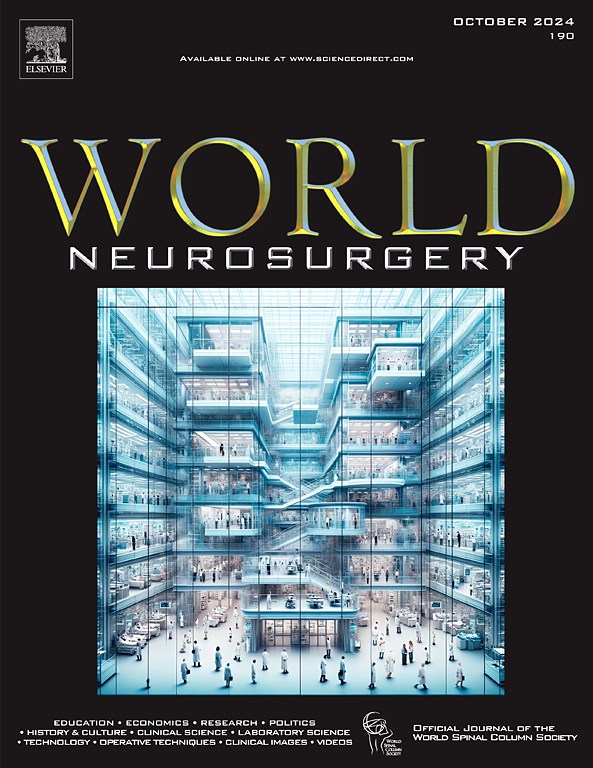低程度椎体滑脱的重要代偿机制:脊柱-骨盆参数的相关分析。
IF 2.1
4区 医学
Q3 CLINICAL NEUROLOGY
引用次数: 0
摘要
背景:当发生脊柱滑脱时,不仅在脊柱内部,而且在骨盆中也会诱发几种代偿机制。我们研究了脊柱从失代偿状态到代偿失调的过程。本研究旨在评估低程度滑脱椎体矢状面失调,并探讨维持矢状面平衡的主要代偿机制。方法:回顾性研究了2016年6月至2017年1月期间60例轻度腰椎滑脱患者和30名无脊柱和骨盆影像学异常的志愿者。根据Meyerding分类,90名参与者分为三组:A组(n=30),正常志愿者;B组(n=30), Meyerding I级脊柱滑脱患者;C组(n=30), Meyerding II级脊柱滑脱患者。对滑移程度与脊柱-骨盆参数进行相关和偏相关分析。采用单因素方差分析(ANOVA)比较正常情况下以及Meyerding I级和II级椎体滑脱患者胸椎后凸(TK)和骨盆发生率(PI)的影响。结果:滑移程度与最大TK(maxTK)(r=-0.344,P=0.002)、PI(r=0.601,P)显著相关。结论:较大的PI可能导致椎体滑脱的发生和发展。在轻度椎体滑脱患者中,相对于正常人群,降低TK是维持矢状位平衡的重要代偿方式。本文章由计算机程序翻译,如有差异,请以英文原文为准。
Thoracic Kyphosis Reduction as the Important Compensatory Mechanism in Low-Grade Spondylolisthesis: A Correlation Analysis of Spinopelvic Parameters
Background
When spondylolisthesis occurs, several compensatory mechanisms are induced not only within the spine itself but also in the pelvis. We investigated the process of spine shift from a decompensated state to compensated malalignment. This study aimed to evaluate the sagittal plane malalignment and explore the major compensatory mechanism for maintaining sagittal balance in low-grade spondylolisthesis.
Methods
This was a retrospective study of 60 patients with low-grade spondylolisthesis and 30 volunteers without radiographical abnormalities of the spine and pelvis conducted between June 2016 and June 2017. Based on the Meyerding classification, 90 participants were divided into 3 groups: group A (n = 30), normal volunteers; group B (n = 30), patients with Meyerding grade I spondylolisthesis; and group C (n = 30), patients with Meyerding grade II spondylolisthesis. Correlation and partial correlation analyses between the slipping grade and spino-pelvic parameters were performed. One-way analysis of variance (ANOVA) was conducted to compare the effects of thoracic kyphosis (TK) and pelvic incidence (PI) in individuals with normal conditions as well as those with Meyerding grades I and II spondylolisthesis.
Results
A significant correlation was found between the grade of slipping and max thoracic kyphosis (maxTK) (r = −0.344, P = 0.002), PI (r = 0.601, P < 0.001), sacrum slope (SS) (r = 0.354, P = 0.001), and pelvic tilt (PT) (r = 0.431, P < 0.001), whereas no significant correlations were observed between the grade of slipping and age, bone mass index, sagittal vertical axis (SVA), and max lumbar lordosis. In partial correction, no significant correlations were observed in the grade of slipping and PT (r = 0.002, P = 0.988) and SS (r = −0.002, P = 0.988). A one-way ANOVA was conducted to compare TK and PI between the groups, and indicated there were significant effect at the P < 0.05 level for the 3 conditions (P = 0.007, P < 0.001).
Conclusions
Greater PI may lead to the development and progression of spondylolisthesis. In patients with low-grade spondylolisthesis, decreased TK acts as an important compensatory way to maintain sagittal balance, relative to the normal population.
求助全文
通过发布文献求助,成功后即可免费获取论文全文。
去求助
来源期刊

World neurosurgery
CLINICAL NEUROLOGY-SURGERY
CiteScore
3.90
自引率
15.00%
发文量
1765
审稿时长
47 days
期刊介绍:
World Neurosurgery has an open access mirror journal World Neurosurgery: X, sharing the same aims and scope, editorial team, submission system and rigorous peer review.
The journal''s mission is to:
-To provide a first-class international forum and a 2-way conduit for dialogue that is relevant to neurosurgeons and providers who care for neurosurgery patients. The categories of the exchanged information include clinical and basic science, as well as global information that provide social, political, educational, economic, cultural or societal insights and knowledge that are of significance and relevance to worldwide neurosurgery patient care.
-To act as a primary intellectual catalyst for the stimulation of creativity, the creation of new knowledge, and the enhancement of quality neurosurgical care worldwide.
-To provide a forum for communication that enriches the lives of all neurosurgeons and their colleagues; and, in so doing, enriches the lives of their patients.
Topics to be addressed in World Neurosurgery include: EDUCATION, ECONOMICS, RESEARCH, POLITICS, HISTORY, CULTURE, CLINICAL SCIENCE, LABORATORY SCIENCE, TECHNOLOGY, OPERATIVE TECHNIQUES, CLINICAL IMAGES, VIDEOS
 求助内容:
求助内容: 应助结果提醒方式:
应助结果提醒方式:


